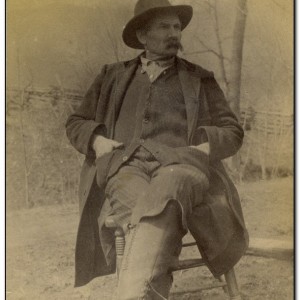“The Missing McCoys,” the first in a series of books that will explore the real history of Tug Valley, which is left almost entirely out of the “feudified” history seen in the feud tales, is now available on Amazon. The book contains much information never before published. It features more than fifty original public documents, most of which have never been published before.
The man on the book cover is Selkirk McCoy, son of Asa and nephew of Ran’l McCoy’s wife, Sally. Selkirk is not a “Missing McCoy” in the feud yarns, but he should have been. He appears twice in the stories, first as a juror in the infamous “hog trial,” and then as an indicted member of the mob that lynched his three cousins on August 9, 1882.
Here is Selkirk, at the age of sixty-one:
At the time the story says that Ran’l McCoy claimed that Floyd Hatfield had his pig, Floyd Hatfield was living on land owned by Uriah McCoy. The pig was on McCoy land! Uriah McCoy was the brother of Ran’l’s wife, Sally, and a first cousin to Ran’l himself. He was also the uncle of Selkirk McCoy.
Spinners of feud yarns never disclose this, because they know that any reader with an IQ above room temperature would ask why Ran’l didn’t go to his cousin and brother-in-law, Uriah, and say, “Hey, Brother, your renter has my pig. Make him give it back to me.”
Readers of this book will never look at the hog trial the same way again.
Selkirk and two of his sons, Albert and L.D., were indicted in September, 1882 for the murders of Ran’l’s three sons who had killed Ellison Hatfield. How in the world was the charge ever made that Asa McCoy’s son and two of his grandsons helped murder three of their cousins directly across the river from Asa’s house?
Surely the names came from either Ran’l and Jim McCoy, as there was no one else who might have talked to the Pike County authorities who had been anywhere near Tug River at that time.
I believe the three McCoy names came from Ol’ Ran’l himself and not Jim, because if Jim McCoy had seen the three McCoys with the Hatfield gang, they would surely have been tried and convicted, rather than turned loose for lack of evidence. With a year to build a case, and two men turning state’s evidence, the Pike prosecutor was unable to build a case against the three McCoys who were charged in the indictment.
This book tells the reader what really motivated the charges of murder against the three McCoys.
One of the most significant facts about the Hatfield-McCoy feud story is that neither of the two most influential Tug Valley McCoys, Uriah and Asa, lifted a finger to help Ran’l. That was the case in 1882 when Ran’l’s three sons were lynched, and it was also true in 1888, when two more of his children were murdered, and his wife, the sister of Uriah and Asa, beaten severely.
This is necessarily ignored by the writers of the feud tales, but it is now dealt with in this book.

